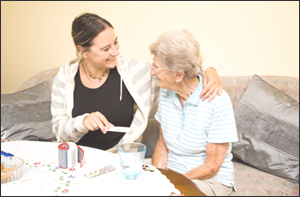Home Healthcare

| Related Safety and Health Topics |
 |
|
|
What is home healthcare?
Home healthcare is healthcare provided in the client's home. Home healthcare workers provide hands-on long-term care and personal assistance to clients with disabilities or other chronic conditions. These workers, who may be home health aides, personal/home care aides, companions, nursing assistants or home health nurses, are employed in patients' homes and in community-based services such as group homes. Depending on their training and job duties, they help patients with activities of daily living such as meals, bathing, dressing and housekeeping, and may perform clinical tasks such as medication administration, wound care, blood pressure readings and range of motion exercises.
What are the hazards in home healthcare?
Home healthcare workers may be employed by a home care agency or may be self-employed independent contractors working directly for patients. They have little control over their work environment which may contain a number of safety and health hazards. These hazards include bloodborne pathogens and biological hazards, latex sensitivity, ergonomic hazards from patient lifting, violence, hostile animals and unhygienic and dangerous conditions. In addition, if their daily work schedule requires them to provide care for multiple patients, they face hazards on the road as they drive from home to home.
Resources
Below are resources to assist in assessing and reducing home healthcare workers' risks for workplace injury and illness.
- OSHA's Guidelines for Preventing Workplace Violence for Health Care & Social Service Workers [624 KB PDF*, 47 pages] provide the agency's recommendations for reducing the risk of workplace violence to workers in healthcare, including home healthcare, and in social services.
- OSHA has posted letters of interpretation that address home healthcare:

- Occupational Hazards in Home Healthcare [789 KB PDF, 68 pages]. US Department of Health and Human Services (DHHS), National Institute for Occupational Safety and Health (NIOSH) Publication No. 2010-125, (2010). The National Institute for Occupational Safety and Health (NIOSH) has published a Hazard Review Occupational Hazards in Home Healthcare to raise awareness of safety and health risks involved in home healthcare and to suggest prevention strategies to reduce injuries, illnesses, and fatalities that occur among workers in this industry.
- NIOSH Science Blog: Strains, Sprains and Pains in Home Healthcare: Working in an Uncontrolled Environment. The most common injuries to home healthcare workers are sprains, strains, and other musculoskeletal injuries related to lifting and moving patients. There are methods for reducing musculoskeletal injuries. The best of these is prevention through ergonomics: designing work tasks to fit workers' strength and abilities. In healthcare, ergonomics involves using equipment and manual handling methods to decrease strain and increase safety when lifting and moving patients.
- NIOSH also has published six Fact Sheets for Home Healthcare Workers which discuss ways to address safety and health risks encountered by these workers:
- Home Healthcare Workers: How to Prevent Exposure in Unsafe Conditions [1 MB PDF, 2 pages]. US Department of Health and Human Services (DHHS), National Institute for Occupational Safety and Health (NIOSH) Publication No. 2012-121, (2012, February). Home healthcare workers may encounter unsanitary homes, temperature extremes, homes without water that is safe to drink, or hostile pets.
- Home Healthcare Workers: How to Prevent Driving-Related Injuries [970 KB PDF, 2 pages]. US Department of Health and Human Services (DHHS), National Institute for Occupational Safety and Health (NIOSH) Publication No. 2012-122, (2012, February). Driving from client to client, home healthcare workers are at high risk for car accidents that could result in injury or death. Distracted driving, aggressive driving, lack of seatbelt use, driving while tired or after having used alcohol or drugs, poor weather conditions, and poorly maintained vehicles can all contribute to car accidents.
- Home Healthcare Workers: How to Prevent Needlestick and Sharps Injuries [775 KB PDF, 2 pages]. US Department of Health and Human Services (DHHS), National Institute for Occupational Safety and Health (NIOSH) Publication No. 2012-123, (2012, February). Needlestick and other sharps injuries are a serious hazard in any healthcare setting. Contact with contaminated needles, scalpels, broken glass, and other sharps may expose healthcare workers to blood that contains pathogens which pose a grave, potentially lethal risk.
- Home Healthcare Workers: How to Prevent Latex Allergies [565 KB PDF, 2 pages]. US Department of Health and Human Services (DHHS), National Institute for Occupational Safety and Health (NIOSH) Publication No. 2012-119, (2012, February). Latex products are made from natural rubber, and sensitivity can develop after repeated exposure. Limiting exposure to latex can help prevent allergic reactions for both home healthcare workers and their clients.
- Home Healthcare Workers: How to Prevent Musculoskeletal Disorders [801 KB PDF, 2 pages]. US Department of Health and Human Services (DHHS), National Institute for Occupational Safety and Health (NIOSH) Publication No. 2012-120, (2012, February). A work-related musculoskeletal disorder is an injury of the muscles, tendons, ligaments, nerves, joints, cartilage, bones, or blood vessels in the arms, legs, head, neck, or back that is caused or aggravated by work tasks such as lifting, pushing, and pulling. Symptoms include pain, stiffness, swelling, numbness, and tingling. Lifting and moving clients create a high risk for back injury and other musculoskeletal disorders for home healthcare workers.
- Home Healthcare Workers: How to Prevent Violence on the Job [518 KB PDF, 2 pages]. US Department of Health and Human Services (DHHS), National Institute for Occupational Safety and Health (NIOSH) Publication No. 2012-118, (2012, February). Home healthcare workers can be vulnerable as they face an unprotected and unpredictable environment each time they enter a client's community and home. The spectrum of violence ranges from verbal abuse, to stalking or threats of assault, to homicide.
Accessibility Assistance: Contact the OSHA Directorate of Technical Support and Emergency Management at (202) 693-2300 for assistance accessing PDF materials.
*These files are provided for downloading.
|



 Newsletter
Newsletter RSS Feeds
RSS Feeds Print This Page
Print This Page
 Text Size
Text Size

